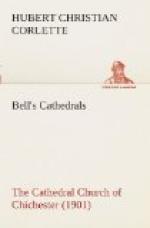Praecentor Walcott has supposed that the two towers in Chichester referred to in the “Annals of Dunstable” as having fallen during the year 1210 were the two at the west end.
[Illustration: CHICHESTER CATHEDRAL, ABOUT 1650.]
But taking Sir Christopher Wren’s report with the discovery made by Mr. Sharpe in 1853, quoted by Professor Willis, it would seem rather that those two towers were the original central tower and that at the south-west angle of the west front.
Wren in writing of the tower at the north-west, which had fallen about 1630-1640, said that it had not been built at the same date nor in the same manner as the other then remaining to the south of the same front. The upper part of the central tower itself had been built perhaps during the second quarter of the fourteenth century or even earlier. Consequently it seems probable that the two towers which fell in 1210 were the original twelfth-century central tower and that of the same date to the south of the west front. In Speed’s map of 1610 both the western towers are represented as having small spires.
Hollar’s print in the “Monasticon” shows what appear to be some fifteenth-century buttresses to the north-west tower; but in excavating for the foundations of the new north-west tower, now completed, no traces of any projecting buttresses were discovered, so it may be that it was the original twelfth-century tower which fell about 1630, and the peculiar character of its masonry suggested the remark to Wren when he said it so distinctly differed from its companion.
Towards the close of the seventeenth century the central spire was in an unstable condition, and Elmes, in his “Life,” says of Wren that he
“took down and rebuilt the upper part of the spire of the cathedral, and fixed therein a pendulum stage to counteract the effects of the south and the south-westerly gales of wind, which act with some considerable power against it, and had forced it from its perpendicularity.”
It is interesting to have this record, for the spire during the following century was still a cause of trouble.
Spershott’s memoirs show that about 1725
“a new chamber
organ was added to the choir of the
cathedral, the tubes
of which were at first bright like
silver, but are now
like old tarnished brass.”
Whether this organ contained any parts of that which was destroyed in the previous century is not known; but many old prints and drawings show that the case of the one that was now built on the top of the Arundel screen was quite as beautifully designed as the one in Exeter Cathedral, or King’s College Chapel at Cambridge.




